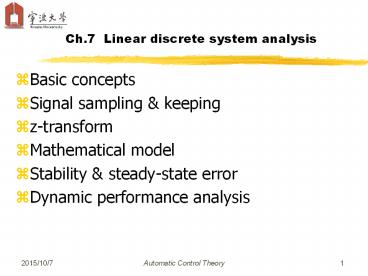Ch.7 Linear discrete system analysis - PowerPoint PPT Presentation
1 / 31
Title:
Ch.7 Linear discrete system analysis
Description:
Ch.7 Linear discrete system analysis Basic concepts Signal sampling & keeping z-transform Mathematical model Stability & steady-state error Dynamic performance analysis – PowerPoint PPT presentation
Number of Views:126
Avg rating:3.0/5.0
Title: Ch.7 Linear discrete system analysis
1
Ch.7 Linear discrete system analysis
- Basic concepts
- Signal sampling keeping
- z-transform
- Mathematical model
- Stability steady-state error
- Dynamic performance analysis
2
7-1 Discrete systems Basic concepts
There is at least one output that takes form of
pulse or digits. The system which signals are
discrete in time is called discrete system. Two
types (1)Sampling control systems or pulse
control systems Signals are discrete in
time only. (2)Digital control system or computer
control systems. Signals are in digital
sequence (discrete in time, magnitude
integer-quantized)
3
Heater sampling control system
Temperature control system with computer (digital)
4
Pulse control systemsimple, low-cost, less
technical requirements
Digital control systemcontroller is manipulated
by computer, more flexible control, more precise,
and easy to implement more functions with
computer, such as system motion state inspection,
alarming, protection, etc. Widely used in
aeronautic, aerospace, military, industry, etc.
Two key parts in digital control systems A/D
converterto convert continuous signals to
discrete signals in time, and magnitude is
digitized to binary integer, namely, sample the
signal in time, and code the signal in magnitude.
5
Normally, it is required that A/D converter
has sufficiently long word (8 bit?10 bit?12
bit?14bit),and step q sufficiently small?
Mean while, if sampling and coding time can be
ignored, then the digital signals may be
considered as pulse signals. A/D converter
may be thought of as an ideal sampling switch
with sampling period TS ?
D/A converterto convert the discrete signals to
continuous signals? It works in two
steps (1)Decode to convert the discrete binary
digital signal to discrete analog signal. (See
p275 , fig 7-8(a)) (2)Reconstruct analog signal
using holder to reconstruct the continuous analog
signals from their discrete analog signals. Only
with this type of analog signals, the analog
amplifier may be driven.
6
Discrete System Analytical Method
(1)Use z-transform to establish discrete system
math model, then analyze and integrate. (2)Use
state space analysis of discrete system
(first-order difference equation) to analyze and
design systems.
7-2 Signal Sampling Hold Sampling
processcontinuous -gt sampler -gt discrete
signals
7
Ideal math description for sampling
Laplace Transform for sampled signal
8
Ex.1 Let ,find L-transform for
Ex.2 Let is
a constant, find L-transform for
9
Shannon Sampling Theorem given signal for
sampler with finite bandwidth and component of
largest frequency ,as long as the sampling
period satisfies
Then may be recovered from the
sampled .
Signal holdoutput of D/A converter is
step-shaped, and formed by the holder internally.
Each sampled value can be held until next
sampling moment, during which the signal
magnitude remain unchanged.
10
Zero-order holder When input an ideal unit pulse
to zero-holder, pulse
response(output)is
Pulse transition function
with magnitude of 1,hold time of T
The corresponding L-transform
11
Zero-holder frequency properties
Properties of zero-holder (1)Low pass (2)Phase
lag (3)Time lag (Average time lag T/2)
First-order holder (skip)
12
7-3 Z - transform(see notes)
7-4 Math Model of Discrete Systems
Modeldifference equation, pulse transfer
function, discrete state-space expressions.
Pulse transfer function with zero initial
condition
13
Pulse transfer function of open-loop (OL)
discrete system
Put a virtual sample switch at the output end.
Seek pulse transfer function G(z)
Continuous transfer function G(s) pulse
response function g(t) digitized by given
sampling period g(t) Z-transform G(z)
Output of virtual switch for the pulse response,
14
Take L-transform
Let
Denote as
Ex.3 Find pulse transfer function for the
system expressed by the difference function?
From real number shift theorem
15
Ex.4
OL (open-loop) system transfer function
Two important properties of L-transform for
sampling (1)Periodic for L-transform of sampling
function
16
(No Transcript)
17
(2)
OL pulse trans-func for serial components
Serial form(1)
18
Output
where
Digitize the output
Notein general
19
Serial form(2)
20
OL pulse trans-func with Zero-order holder
After digitization
21
Ex.1Let trans-func be
Find pulse trans-func with Zero-order holder
22
When is a rational fraction function of
s, the Z-transform of the expression above
must also take form of rational
fraction function
23
Pulse transfer function of close-loop (CL) system
L-transform of continuous output signal
24
Z-transform
Pulse trans-func of CL system
Pulse trans-func of error
Characteristic func of CL system
Pulse trans-func of OL
25
AttentionDiscrete systems CL pulse trans-func
cannot be obtained directly from its
corresponding continuous systems trans-func.
CL system with more than two sampling switches
has the pulse trans-func as follows
26
(No Transcript)
27
Corresponding pulse trans-func (PTF)
28
Some locations of sampling switch will result in
no PTF, such as in the structure below
????
29
Refer to 7-3 for Z-transforms for typical CL
discrete systems or outputs
Limitations of Z-transform (1) Derivation of
Z-transform is based on ideal sampling
sequence?The real-time sampling sequence
possesses certain width. Only when such width is
sufficiently small compared to the maximum system
time constant, Z-transform can be held. (2)C(z)
only reflects the value at moment c(t),cant
reflect the information in between. (3)Analyzing
discrete systems using Z-transform requires the
order of denominator of continuous portion is at
least higher by 2 than that of numerator, only in
this case the result of using Z-transform is
correct.
30
Ex.For R-C circuit,giving a pulse sequence as
input,
Let sampling period T1 sec,the corresponding
Z-transform is
31
Let input be unit step signal
In fact, however, the actual output is that
driven by , demonstrates
charge-discharge process, as shown in fig. 7-30
on page 314. Solution use revised Z-transform.































